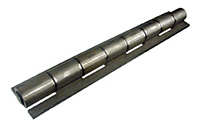
You shouldn’t believe everything you read or hear about piano hinges. Like all hinges, piano hinges are mechanical bearings. They are used to connect two objects while simultaneously allowing a limited angle of rotation between the objects. Piano hinges, however, are longer than other hinges. If you’re thinking about buying a piano hinge, you should familiarize yourself with the following myths about them.
#1) Only Used on Pianos
Don’t let the name fool you into thinking that piano hinges are only used on pianos. Most pianos do, in fact, have a piano hinge; it’s used to connect the lid to the base of the piano. But piano hinges are used on other types of objects as well. You can find them on doors, cabinets, chests, toolboxes, medical equipment, vehicles and more.
#2) Different From Continuous Hinges
Some people assume that piano hinges are different from continuous hinges, but this isn’t the case. The terms “piano hinge” and “continuous hinge” both refer to hinges that run the entire length — or nearly the entire length — of the objects with which they are used. They were initially known as “piano hinges” because they were designed for use with pianos. As other applications emerged, though, they also became known as “continuous hinges.”
#3) Not Suitable for Heavy Loads
Piano hinges are absolutely suitable for heavy loads. These long, full-length mechanical bearings typically support heavier loads than traditional, shorter hinges. This is because they distribute the weight of the load across the objects with which they are used. For high-stress applications that involve heavy loads, there’s no better choice than a piano hinge.
#4) Only Available in Steel
Another common myth about piano hinges is that they are only available in steel. You can certainly find piano hinges made of steel. Stainless steel and carbon steel are two of the most common materials in which they are made. But piano hinges are available in other materials as well, such as aluminum. Aluminum piano hinges weigh less and offer better protection against corrosion than their steel counterparts.
#5) Only Available With Holes
While most piano hinges have holes, some of them feature solid leafs without any holes. Holes, of course, are used for fasteners. You can drive a set of screws through a piano hinge’s holes and into the underlying object. If a piano hinge doesn’t have holes, it will likely support a different method of installation, such as welding.
